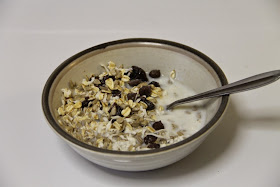There comes a time in every man's life when he begins to wonder, "what if I didn't eat cooked oatmeal with brown sugar and raisins for breakfast every day?" As excellent a dish as cooked oatmeal is in terms of nutrition, flavor, inspiring creativity (what if I added cinnamon?), staying power, and economics, it can't compete with cold breakfast cereal in terms of preparation time. (scoop oats, pour milk, cook for two whole minutes in the microwave?!, stir in sugar and raisins...it's a good five minutes before we even get to the eating part!)
Fortunately, there is a way to combine the best parts of both oats and cold cereal. Enter müsli (or muesli or müesli). Raw oats are surprisingly edible, and mixing them with dried fruits, seeds, and nuts makes them even more so, without requiring the added sugar for cooked oatmeal (or granola, for that matter). Here's how we make a week's worth of breakfasts in the five minutes it takes to prepare a single bowl of cooked oatmeal.
 |
| Hey, that looks like a pretty good breakfast! |
What do you eat for breakfast? What's your favorite muesli recipe? Let us know in the comments section below!








































